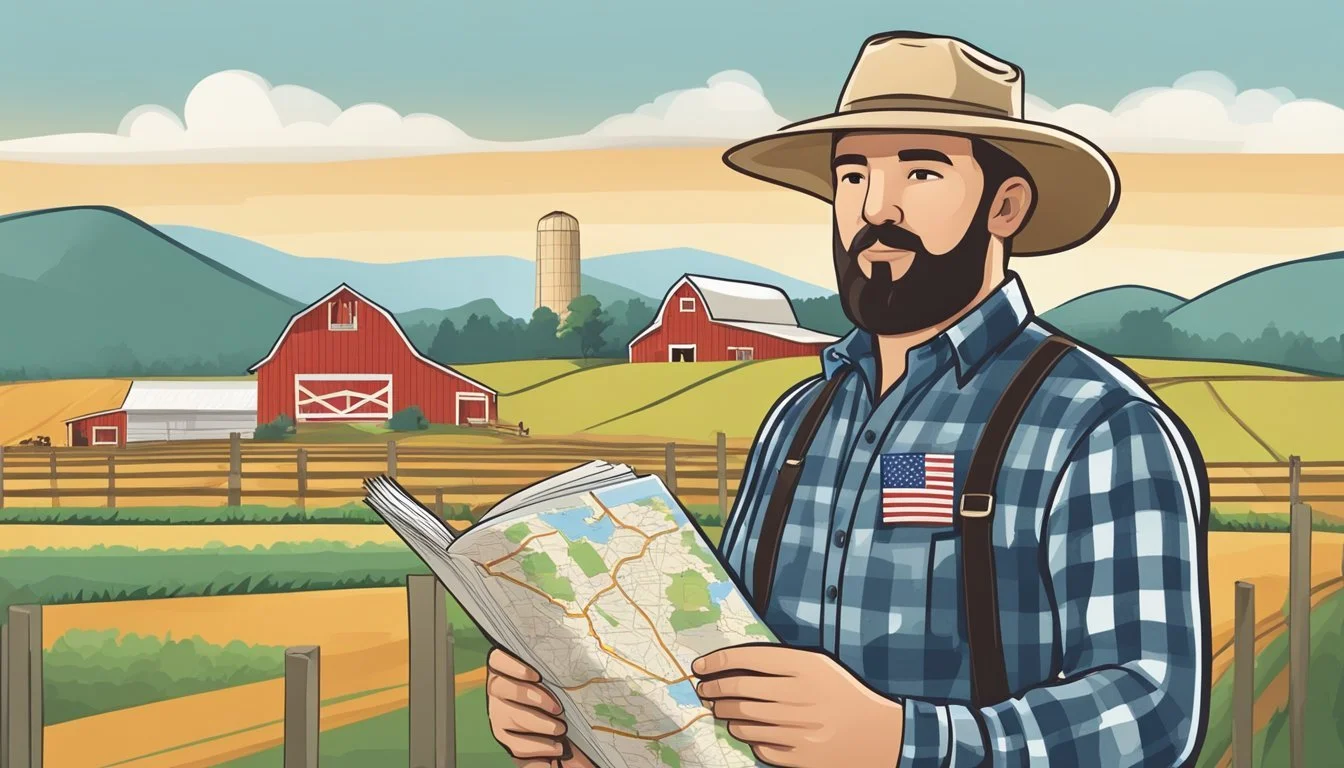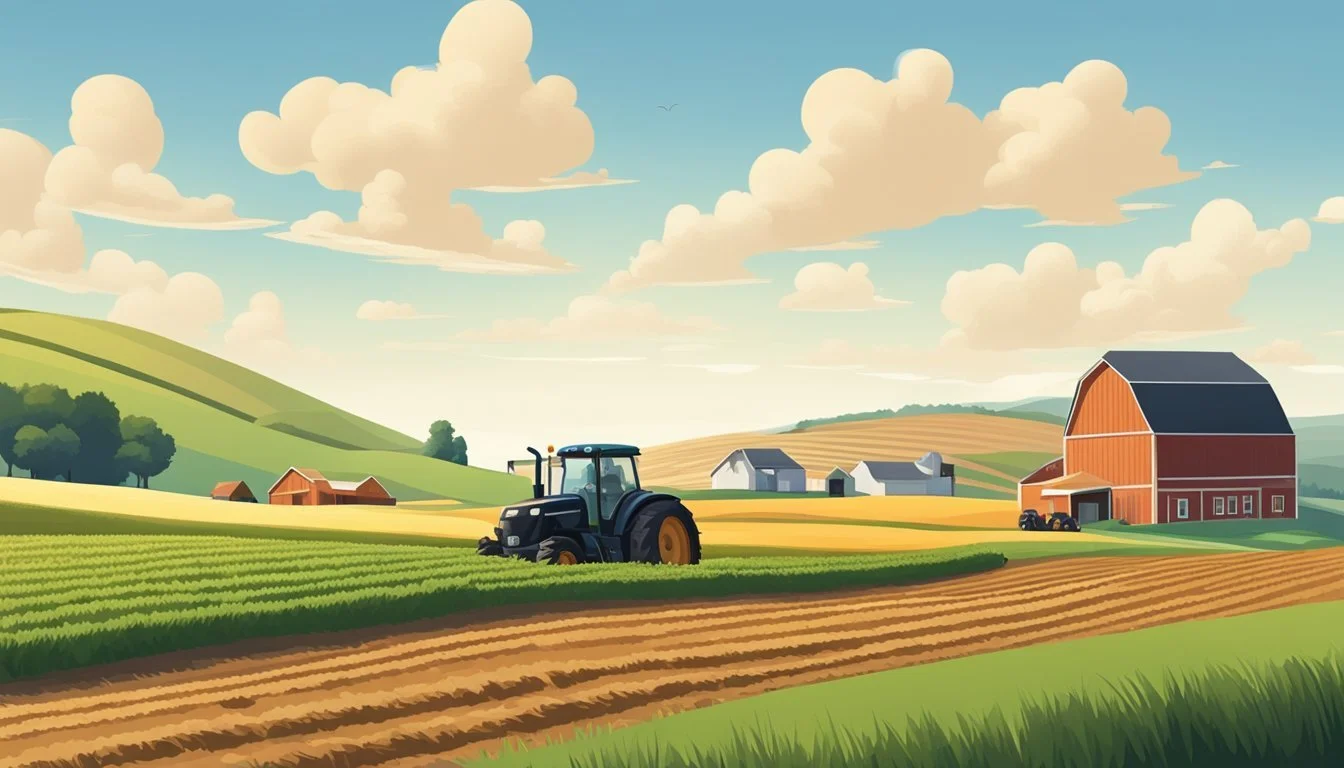Farm Loan Guide For All 50 US States
Navigating Your Agricultural Financing Options
Farm loans are vital financial tools for farmers and ranchers across the United States, offering the necessary support for starting, expanding, maintaining, and improving agricultural operations. Access to capital can be a significant barrier for those in the agricultural sector, especially for beginners and small farm owners. To address these challenges and promote a thriving agricultural economy, various farm loan programs are available, tailored to the unique needs and conditions present in all 50 states.
Each state offers a portfolio of loan options through the USDA Farm Service Agency (FSA) and other local agencies and financial institutions. These loans are designed to cater to a diverse range of needs within the farming community, including purchasing land, buying equipment, funding for operational expenses, and facilitating necessary improvements. Eligibility criteria, terms, and application processes for these loans can vary widely depending on the state and the specific program, making it crucial for farmers and ranchers to be well-informed about their options.
Understanding the ins and outs of these farm loan programs enables producers to make educated decisions about their financing options. The USDA and other agencies also provide tools and resources to assist in determining eligibility, developing business plans, and navigating the application process. With the right information, farmers and ranchers can leverage these loans to sustain and grow their operations effectively.
How to Get a Farm Loan in My State?
Navigating the landscape of agricultural financing can be daunting for farmers and ranchers across the United States. Whether you're looking to purchase new land, expand your operations, or invest in necessary improvements, understanding the array of farm loan programs available in each state is crucial. This comprehensive guide will explore the various options, from USDA Farm Service Agency's nationally available loans to state-specific programs designed to support your agricultural business. Discover eligibility criteria, application tips, and how these loans can help turn your farming aspirations into reality, state by state.
How to Get a Farm Loan in Nevada
Understanding Farm Loans in the US
Farm loans in the United States are designed to support the agricultural sector, offering financial options for different farming needs. They cover expenses such as buying livestock and equipment, as well as operating costs for both new and established farmers.
Overview of USDA Loans and Programs
The United States Department of Agriculture (USDA) offers a variety of loans and programs aimed at fostering growth and stability in the nation's agricultural industry. These programs serve to promote, build, and sustain family farms, ensuring a thriving agricultural economy. The USDA ensures that farmers across the country have access to loans necessary to start, maintain, and expand their agriculture businesses.
The Role of the Farm Service Agency (FSA)
The Farm Service Agency (FSA) operates under the USDA to administer various farm loan programs. The FSA provides direct loans and guaranteed loans, helping farmers and ranchers with the needed capital to establish and grow their operations. The FSA emphasizes support for beginning farmers and ranchers, as well as for minority and tribal members, aiming to provide diverse communities with fair access to agricultural financing.
Types of Farm Loans Available
Operating Loans: These loans help farmers fund their day-to-day operational needs, which can include purchasing livestock, seed, and equipment or covering family living expenses.
Farm Ownership Loans: Designed to assist farmers in purchasing or expanding their farms, these loans facilitate the acquisition of property.
Emergency Loans: In times of crisis such as a natural disaster, emergency loans provide relief to help farmers recover and continue their farming operations.
Targeted Loans for Specific Groups: There are specialized loans such as the Highly Fractioned Indian Land Loan Program for Native American tribal land, and the USDA also supports loans for farmers in Puerto Rico. These programs address unique challenges and bolster agricultural activities in these communities.
Eligibility and Requirements
When considering farm loans in the United States, one must navigate through specific eligibility and loan requirements. This encompasses meeting criteria such as experience in farming, credit history, and status as a beginning farmer.
Determining Your Eligibility
Eligibility for farm loans is based on several factors. The USDA Farm Service Agency (FSA) typically requires applicants to demonstrate:
Experience: A minimum of three years of farming or ranching experience is needed. This can be proven through active engagement in farm operations.
Credit History: Satisfactory credit history is essential. Applicants should have no federal or state convictions for planting, cultivating, growing, producing, harvesting, storing, trafficking, or possession of controlled substances.
Beginning Farmer Status: A 'Beginning Farmer' is someone who has not operated a farm or ranch for more than 10 years. Special loan programs may cater to these individuals.
Key Requirements for Farm Loans
Here are some of the prime loan requirements applicants must fulfill:
Primary Borrower: Applicants must be the primary operator of the farm or ranch.
Loan Purpose: Loans must be for valid agricultural purposes.
Owner-Operator: Borrowers should own or aim to own the agricultural land they work on.
Eligibility requirements detail who can apply, while loan requirements outline the conditions of the loan itself, such as its intended use, the need for a solid business plan, and the alignment with USDA guidelines.
Loan Application and Approval Process
When seeking farm loans across the United States, applicants should prepare for a clear-cut application process and understand the specific repayment terms and interest rates which vary by loan type and provider.
Navigating the Application Process
The initial step in the farm loan application process is to gather necessary documentation, which typically includes proof of identity, farm business plan, credit history, and collateral. Applicants meet with a loan officer to discuss loan options, which may encompass ownership loans, operating loans, and emergency loans from providers such as the USDA's Farm Service Agency (FSA). It is essential for applicants to provide detailed and accurate information to the loan officer to facilitate a smooth process.
During the application process, applicants will be required to fill out specific forms depending on the type of loan they are seeking. For example, FSA loans may require different documentation compared to private lenders. The application will be extensively reviewed for the borrower’s creditworthiness, farming experience, and the viability of the farm business plan.
Understanding Repayment Terms and Interest Rates
Repayment terms for farm loans typically range from short-term loans of 1-7 years to long-term loans that can extend up to 40 years. Borrowers should clarify the repayment schedule, which could be monthly, quarterly, or at other intervals agreed upon with the lender.
Interest rates are a critical aspect to consider, as they affect the total cost of the loan over time. The FSA loan interest rates, for instance, are set by the government and can offer fixed rates that are often lower than commercial lenders. Private lenders' rates can vary widely and may be fixed or variable. Borrowers should compare interest rates and terms from different sources to ensure the most cost-effective loan is chosen for their needs.
Across all 50 states, these factors—loan options, application process details, repayment terms, and interest rates—determine the path to acquiring a farm loan and its affordability in the long run.
Farm Ownership and Operating Loans
Farm Ownership and Operating Loans are designed to support the acquisition and sustainability of farm operations. These loans provide essential capital for purchasing farmland, equipment, and funding ongoing operating expenses and improvements.
Acquiring Farmland and Equipment
Farm Ownership Loans enable individuals to purchase or expand properties, which can be pivotal for establishing and strengthening a farm's foundation. The USDA Farm Service Agency specifies that a maximum loan amount of $600,000 is available, catering to various sizes of family farms and operations. Borrowers may utilize these loans to:
Buy land and construct or improve buildings
Install or improve water systems
Typically, a down payment is required, and the funds can also be used to acquire equipment necessary for the farm's productivity.
Funding Operating Expenses and Improvements
Operating Loans focus on covering the day-to-day expenses of running a farm. These may include but are not limited to:
Seed and fertilizer costs
Livestock and feed purchases
Farm equipment repairs
With an operating loan, farmers have the ability to maintain cash flow, improve farm operations, and respond to market demands efficiently. These loans assist with not only immediate needs but also with implementing operational improvements.
Specialized Loan Programs
The United States Department of Agriculture (USDA) offers a variety of specialized loan programs to support different groups of farmers and individual needs. From those just starting out to young individuals pursuing agricultural education and farmers facing the unexpected challenges of natural disasters, each program is tailored to provide necessary financial assistance.
Loans for Beginning Farmers and Ranchers
USDA recognizes the barriers that new entrants to farming face. Beginning Farmers and Ranchers Loans provide credit to this group who often have difficulty obtaining financing through traditional sources. These loans offer:
More favorable terms such as reduced down payments and interest rates.
Training and educational opportunities to ensure long-term success.
Eligibility criteria often stipulate that individuals must be operating a farm for not more than 10 years.
Youth Loans and Educational Programs
Youth Loans are designed for individuals between the ages of 10 to 20 years who are involved in 4-H clubs or Future Farmers of America (FFA). These loans encourage younger individuals to acquire hands-on training and experience in farming. Key aspects include:
Maximum loan amount of $5,000.
Funds can be used for agricultural projects lasting one to nine years aligned with their organization's objectives.
Emergency Loans for Natural Disasters
Emergency Loans step in when natural disasters such as droughts, floods, or other calamities strike. They provide essential funds to:
Restore or replace essential property.
Cover all or part of production costs associated with the disaster year.
Pay essential family living expenses.
Farmers in designated disaster areas are eligible, with the stipulation that they must have suffered a qualifying loss in production or physical loss of assets.
Loan Funding, Terms, and Expansion
The Farm Loan Guide addresses key financial aspects required to support agricultural activities across all 50 states. These include understanding how to determine loan funding, setting appropriate repayment terms, and leveraging capital for growth and expansion.
Determining Loan Amount and Funding Options
Each state offers a variety of loan funding options, intended to suit different types of agricultural operations. Loan amounts are generally determined based on the borrower’s need, repayment ability, and the type of loan applied for. For instance, the Farm Service Agency (FSA) provides microloans up to $50,000 for smaller needs and can offer larger farm operating loans up to $400,000. Funding options may include:
Direct Loans: Provided by government agencies such as the USDA.
Guaranteed Loans: Offered by commercial lenders with government guarantees.
Microloans: Tailored for smaller scale financing needs.
The applicant's aim should be to accurately calculate the required loan amount to adequately cover costs without overborrowing. They might use this funding to start or grow their farming operations effectively.
Setting Terms and Planning for Expansion
Loan terms typically reflect the nature of the agricultural operation and its projected income, with repayment schedules designed to align with seasonal cash flow. The following points elucidate the terms aspect:
Interest Rates: These are generally competitive and may be fixed or variable.
Repayment Period: Can range from a few years for microloans to longer terms for substantial loans meant for expansion.
For farmers looking to expand, securing additional funding can be pivotal. The process should be approached with a strategic plan to ensure that the expansion does not over-leverage the operation's financial stability. Terms and additional loans should sustain growth without compromising the farm's operational integrity.
Working with Lenders and Insurance
When engaging with lenders and navigating insurance options, farmers and ranchers must understand the various avenues for financial assistance and risk management. It is crucial for them to establish strong relationships with commercial lenders and leverage crop insurance and guarantees to ensure financial sustainability and recover from unforeseen losses.
Collaborating with Commercial Lenders
Farmers seeking loans often turn to commercial lenders, including banks and Farm Credit Services, for the necessary capital. The Farm Service Agency (FSA) offers loan guarantees that can mitigate lender risk, enabling farmers to receive more favorable loan terms. For instance, the FSA can guarantee loans up to a certain threshold, adjusted annually for inflation, which as of the last update stands at $1,214,000. It is vital for farmers to present comprehensive business plans and demonstrate creditworthiness to engage effectively with commercial lenders.
Utilizing Crop Insurance and Guarantees
Crop insurance plays a pivotal role in managing agricultural risks. It serves as a safety net against crop loss due to natural disasters or price fluctuations. Farmers can purchase crop insurance from private agents, with policies that are reinsured by the Federal Crop Insurance Corporation (FCIC) and often must have it to secure loans from commercial lenders. In addition, the USDA provides guarantees through various programs, ensuring that farmers can recover and maintain operations post adversity. Familiarity with the terms and the scope of coverage is essential for farmers to maximize the benefits of crop insurance and FSA guarantees.
Additional Resources and Support
For farmers seeking comprehensive assistance with farm loans, there are substantial resources available to guide them through various lending options and provide support for the application process. The focus is on utilizing these resources to secure the necessary funds for agricultural endeavors.
Exploring FSA Resources and Tools
The Farm Service Agency (FSA) offers a suite of resources tailored for both new and experienced farmers. Specifically, the FSA website, farmers.gov, is equipped with a loan assistance tool to help individuals navigate the different loan options available. The FSA provides several loan types:
Farm Ownership Loans
Operating Loans
Microloans
Youth Loans
Emergency Loans
Farmers can leverage these tools to develop a business plan, evaluate loan eligibility, and understand the best practices for land stewardship.
Accessing Loan Assistance and Support Centers
For on-the-ground assistance, visiting a local USDA Service Center can be invaluable. Service center staff offer one-on-one support, helping farmers to:
Review application requirements
Complete necessary FSA forms
Discuss loan terms and conditions
Understand repayment structures
These centers aim to streamline the loan application process, reducing uncertainty and fostering successful lending outcomes. Through personal guidance at support centers, farmers access a network of resources designed to help them achieve their farming goals.
Building a Sustainable Farm Business
When embarking on creating a sustainable farm business, it's essential for farmers to meticulously plan and understand the integration of sustainability and conservation into their business models.
Developing a Farm Business Plan
A farm business plan serves as a comprehensive blueprint for the establishment and successful operation of a farming enterprise. It should detail several crucial components including, but not limited to, an executive summary, farm description, market analysis, organizational structure, and a set of financial projections.
Executive Summary: A concise overview of the farm's objectives and the means to achieve them.
Farm Description: Detailed information about the farm, including size, location, and types of production.
Market Analysis: An examination of the current market, target customers, and competitive strategies.
Organizational Structure: An outline of the farm's management hierarchy and operational plan.
Financial Projections: Itemized forecasts of income, expenses, and profit for both the short and long term.
Addressing Sustainability and Conservation Efforts
Sustainability and conservation efforts are at the heart of a sustainable farm business. They ensure the long-term viability of the soil and water resources essential for agriculture. Strategies for sustainability include:
Soil Conservation: Methods such as crop rotation, cover cropping, and reduced tillage to prevent soil degradation and enhance fertility.
Water Conservation: Technologies and practices like drip irrigation, rainwater harvesting, and wise water management to ensure efficient use of water resources.
Farmers should incorporate conservation plans into their business plans, focusing on both environmental stewardship and economic viability. By doing so, a farm business can sustain itself and its resources for future generations while remaining profitable and competitive.
Considering Additional Financial Aspects
In navigating farm loans across the United States, farmers must carefully consider the impact of operating costs, real estate markets, and economic changes on their finances.
Managing Farm Operating Costs and Living Expenses
Farmers face a myriad of expenses that include operating costs such as labor and fuel, and family living expenses. They must balance the cost of hiring sufficient labor with the fluctuation of fuel prices. Some choose to engage with local credit unions or form a cooperative to achieve more favorable terms for essential purchases and loans.
Navigating Land Loans and Real Estate Markets
Accessing land loans requires understanding the nuances of real estate markets in various states. A significant factor is the down payment required, which varies widely and can impact a farmer's ability to secure credit. Farmers might consider various lending institutions, including traditional banks or specialized farm credit agencies, when seeking financing for land.
Adapting to Economic Challenges and Inflation
Inflation can greatly affect a farmer’s budget, from the cost of inputs to the value of their products in the market. Farmers must adapt by implementing cost-saving measures and strategically planning their purchases. It’s crucial to monitor market trends and anticipate the need for short-term adjustments or long-term operational changes to remain financially viable.







